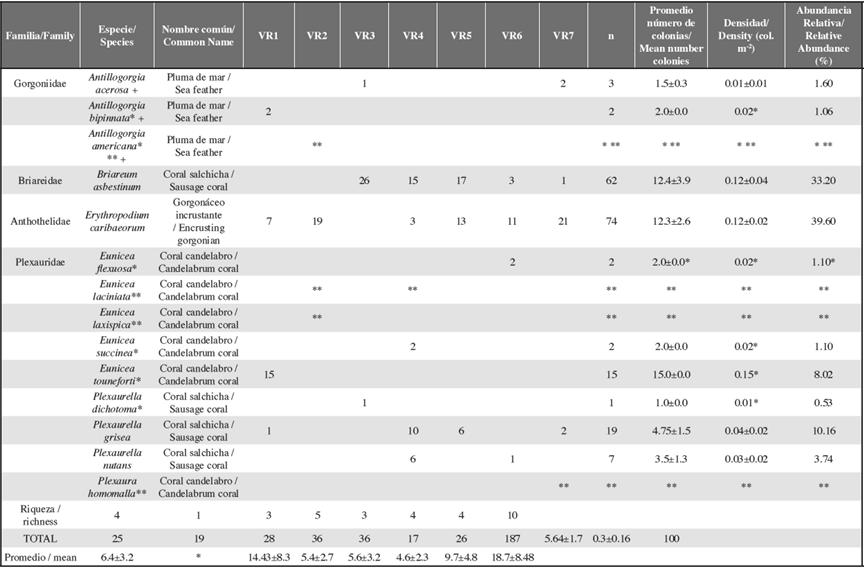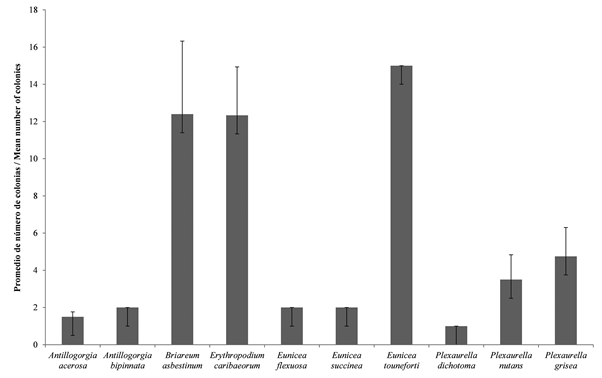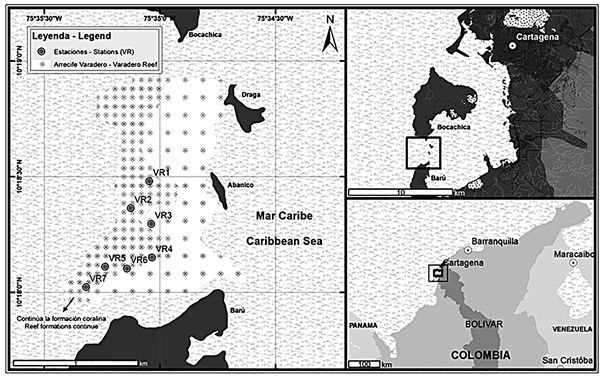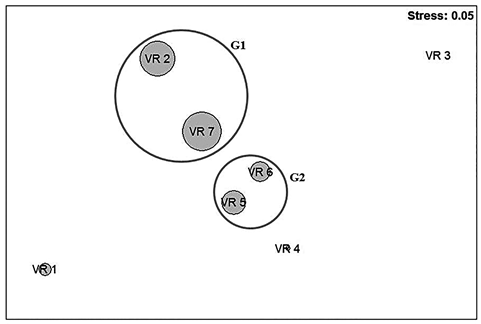Serviços Personalizados
Journal
Artigo
Indicadores
-
 Citado por SciELO
Citado por SciELO -
 Acessos
Acessos
Links relacionados
-
 Citado por Google
Citado por Google -
 Similares em
SciELO
Similares em
SciELO -
 Similares em Google
Similares em Google
Compartilhar
Boletín de Investigaciones Marinas y Costeras - INVEMAR
versão impressa ISSN 0122-9761
Bol. Invest. Mar. Cost. vol.48 no.1 Santa Marta jan./jun. 2019 Epub 30-Ago-2019
https://doi.org/10.25268/bimc.invemar.2019.48.1.757
Research Articles
Gorgonian octocoral community at Varadero coral reef in the Colombian Caribbean: diversity and spatial distribution
1 Okeanos Asesoría Ambiental SA.S. Carrera 3 # 1-14 Bello Horizonte. Santa Marta, Magdalena, Colombia. nelson.manrique@okeanosambiental.com.
2 Sanjuan y Asociados Ltda. Calle 17 # 4-50 El Rodadero. Santa Marta, Magdalena, Colombia. clauctg@hotmail.com.
3 Universidad de Bogotá Jorge Tadeo Lozano. Carrera 2 # 11 - 68 El Rodadero. Santa Marta, Magdalena, Colombia. adolfo.sanjuan@utadeo.edu.co.
Varadero reef has unique ecological characteristics and faces the risk of disappearing because of the dredging for an access channel of large vessels to the Cartagena port in Colombia. In this ecosystem, the sessile benthic community, such as gorgonian octocorals and associated fauna, will be impacted. We examined the diversity and spatial distribution of gorgonians from seven sites located in the mixed coral reef zone. These organisms are generally found in depths between 6 and 10 m in the area. The richness of the gorgonians species is lower than that recorded in other areas of the Caribbean. The low values of abundance and richness species are due to the characteristics of reef setoff and sedimentation processes existing in Cartagena bay.
KEY WORDS: Gorgonians; Composition; Varadero; Colombian Caribbean
El arrecife de Varadero tiene características ecológicas únicas y enfrenta el riesgo de desaparecer debido al eventual dragado de un canal de acceso, que se construiría para el ingreso de grandes embarcaciones al puerto de Cartagena (Colombia). En este ecosistema, la comunidad bentónica sésil, como los octocorales gorgonáceos y la fauna asociada, se vería seriamente afectada. Se examinó la diversidad y la distribución espacial de gorgonáceos de siete sitios ubicados en el área de arrecifes mixtos. Estos organismos se encontraron en el área de estudio a profundidades entre 6 y 10 m. La riqueza de especies de gorgonáceos fue menor que la registrada en otras áreas del Caribe. Los bajos valores de abundancia y riqueza de especies pueden obedecer a las características del relieve arrecifal y a los procesos de alta sedimentación que existen en la bahía de Cartagena.
PALABRAS CLAVE: Gorgonáceos; Composición; Varadero; Caribe colombiano
INTRODUCTION
Coral reefs are enduring a global crisis due to natural and human impacts (Wilkinson, 2008). Healthy coral reefs are estimated to provide benefits of up to US$375 billion on an annual basis, generated through a range of services, including tourism, fisheries, and extractive industries (Cote and Reynolds, 2006). This is particularly significant when two thirds of all countries with coral reefs are developing, of which, one quarter are between the less developed (Erftemeijer et al., 2012). Caribbean reefs have been particularly impacted, with coral cover reducing from an average of 50 % to 10 % in four decades, resulting in a phase shift from coral to macroalgal domination with a concurrent increase in sponge abundance (Jackson et al, 2014). For example, the bay of Cartagena in Colombia has been subject since the 15th century to a continuous disturbance from fresh water and sediment inputs from the Canal del Dique, a channel dug by the Spaniards to connect the bay with the Magdalena River, the main fluvial route used ever since the colonization for commerce with the Andean hinterlands. This channel generated substantial changes in water quality, causing high turbidity and sedimentation, transforming the bay in a eutrophic system and causing a high loss of coral cover in the area and other nearby locations such as the Rosario Islands (López-Victoria et al, 2015). The few coral formations that were located in the area have suffered from the continuous dredging and the traffic of large commercial vessels (Wade, 2016; Pizarro et al, 2017).
Cartagena has one of the busiest maritime transport systems in the southern Caribbean, originating an important economic development in the region as well as in the country, with different productive activities such as tourism, port traffic, and industrial development. Their growth has motivated the port authorities to suggest the construction of a new access channel for large (e.g. Neopanamax) vessels right beside the current Bocachica entrance, along the shallows known as Varadero, located between Abanico Island and the north of Barú Island. This channel will grant competitive advantages to the port area of the city. Paradoxically, during the environmental impact studies for the channel, it was discovered that beneath a layer of murky waters, Varadero holds a thriving coral formation with up to 80 % of living coral cover, dominated by large, long-lived colonies of Orbicella spp., the main reef-building corals in the Caribbean. This project involves the dredging of a canal right through the reef itself, seriously impacting the coral formations and their associated organisms (Pizarro et al., 2017).
Among marine organisms, octocorals constitute one of the most notorious living components with great ecological importance in the Caribbean Sea (Jackson, 1977). They have the capacity to modify the structure of the substratum, and provide habitat for other organisms such as mollusks, sponges, algae and other sessile epibionts, as well as settlement sites for fish (Bayer, 1961), thus increasing the local diversity. In this study, we provide a characterization, we provide a characterization of gorgonians from the Varadero reef, in terms of relative abundance, species richness and density, in order to have a baseline of the area, which complements other studies that have been carried out for other organisms (Pizarro et al., 2017), and analyze the possible impact of the activities carried out for the construction and dredging of the new access channel on the octocoral community structure.
STUDY AREA
The study was conducted from May to July 2011 on the coral reefs in the Varadero area, Cartagena, Colombia (10°18'13"N, 75°35'19"W). This area consists of shallow back reef lagoon limestone terraces and sea grass beds with interspersed stony corals and gorgonians, followed seaward by a compact, fairly continuous fringing coral reef from 2 to about 10 m in depth (Pizarro et al., 2017). A preliminary inspection was carried out in the reef, where seven stations with a representative presence of gorgonians were selected and georeferenced (Figure 1).
MATERIALS AND METHODS
Field and laboratory work
The first scuba dive was dedicated to specimen collection and photography that helped in the preliminary species identification, followed by seven additional dives that were used to conduct the quantitative analyses. In each station, a band transect of 50 x 2 m (100 m-2) was evaluated and all octocoral specimens were photographed in situ. A small branch segment of 10-15 cm was cut from the distal tips of branches, and preserved in 95 % ethanol. The species were identified using microscope slide preparations of sclerite morphology, using established protocols for octocoral identification (Bayer, 1961; Sánchez and Wirshing, 2005).
Data processing and statistical analysis
At each station, density (colonies x m-2), species richness and relative abundance (%) of each species were calculated. Margalef Richness D, Pielou Uniformity J', Shannon-Wiener Diversity H' and Simpson Predominance À diversity measures were calculated. A station resemblance matrix was produced using the Bray-Curtis distance based on log (1+Y) transformed data, using PRIMER 7 software (Clarke and Gorley, 2015). With the transformed data (log (x +1)) an non-metric multidimensional scaling analysis was carried out, using the Bray-Curtis similarity coefficient and the average linkage technique (Clarke et al., 2014). The arithmetic mean and its standard error was calculated.
RESULTS
Community structure
In the Varadero reef, 14 gorgonian species belonging to four families (Briareidae, Anthothelidae, Plexauridae and Gorgoniidae) were recorded. Of the 10 species found within transects, 187 individuals were counted. The most abundant species were Erythropodium caribaeorum (12.33±2.60 colonies x m-2), Briareum asbestinum (12.4±3.92 colonies x m2), Plexaurella grisea (4.75±1.55 colonies x m-2), and Eunicea touneforti (15.00+0.00 colonies x m-2), which together constituted 91% of the abundance (Table 1, Figures 2 and 3). Other species such as Plexaurella nutans and Antillogorgia acerosa showed very low values (3.5±1.3 and 1.5±colonies x m-2 respectively). It should be noted that some species of commercial use (Figure 3E, see Manrique et al., 2007) in the region, such as sea feathers of the genus Antillogorgia (A. acerosa and A. bipinnata), did not exceed 2.6 % of total relative abundance. Also, none of the gorgonians found in the present study are included in the red list of threatened species in Colombia (Ardila et al., 2002).
Table 1 Gorgonians structure at Varadero reef (VR). Total number of colonies (n), mean number of colonies (±1 standard error), density (colonies m-2) and relative abundance (%). * Species recorded in a single station. ** Species recorded outside the sampling stations and not included in the community structure analysis. + Species of economic importance.


Figure 2 Overall mean (±1 standard error) number of colonies of each gorgonian species found at Varadero reef.
Despite the low species richness of gorgonians for the area, it should be remarked that stations VR1, VR4, VR6, and VR7 had the highest number of species (Table 1). These stations are characterized by the presence of a mixed coral reef landscape (sensu Díaz et al., 2000) dominated mainly by Orbicella spp. and Agaricia tenuifolia corals that intermingle with coral colonies of Colpophyllia natans, Favia fragum, Helioseris cucullata, Isophyllia sinuosa, Pseudodiploria strigosa, Millepora complanata, Scolymia cubensis, Porites astreoides, Porites divaricata, and Porites porites. The abundance and highest mean value was observed in VR5 (36 individuals, 5.6±3.2) and VR4 (36 individuals, 5.4±2.7), while the lowest values were found in VR6 (17 individuals, 4.6±2.3). The density of colonies per species showed low values and fluctuated between 0.12 ± 0.04 colonies m-2 and 0.01 ± 0.01 colonies m-2 (Table 1).
Species diversity
Diversity values were similar among the seven stations. However, VR1 station stands out with the highest Shannon-Wiener index (H'loge = 1.39 nits), in congruence with Pielou uniformity (J' = 0.86), the amount of taxa (S = 4) and Margalef richness (D = 1.11). However, the predominance of taxa (λ = 0.57) indicates a low diversity. The VR2 station presented a single species and the VR3 station presented the lowest values in the Shannon-Weiner index (H'loge = 0.31 nits), as well as the lowest uniformity (J'= 0.28), which agrees with the field observations, where the abundance and richness are low in these stations (Table 2).
Spatial distribution
nMDS analysis (Figure 4) showed two main groups between stations with a high-level of similarity. The first group (G1) contains stations VR2 and VR7, which share the highest density values of Erytlropodium caribaeorum. The second group (G2) contains stations VR5 and VR6, which share similar values in richness and number of individuals of the most abundant species (E. caribaeorum). This is explained by E. caribaeorum, the only encrusting octocoral of the Caribbean, and the most abundant species of the area, has a clear aggregation between stations in which it has been recorded, a behavior that has been similar for the other main recorded species. The other stations are separated from these two groups by changes in species richness and density, especially due to the low density of E. caribaeorum in stations VR1 and VR4 as well as the absence of this species in station VR3.
DISCUSSION
Abundance values and density of gorgonians recorded for this study are low compared to other studies that doubled or tripled species richness (between 25 and 48 species versus 14 species recorded in current study) in the Cartagena area and Caribbean Sea (Lasker y Coffroth, 1983; Botero, 1987; Sánchez, 1992; Sánchez et al, 1998; Alcolado et al., 2008; Camargo et al., 2008; Etnoyer et al., 2010). However, it should be noted that those other studies cover more extensive areas and were done on a broader time scale using different sampling techniques.
The low abundance and richness of species found in Varadero is probably caused by high sedimentation, produced by the Canal del Dique and maritime activities, which are important agents of coral decline that largely control distribution and community structure of shallow-waters octocorals as it has been evidenced in other areas in the Caribbean (Yoshioka and Yoshioka, 1989). Therefore, apart from the total removal of a meaningful section of the reef framework and its accompanied biota for the new planned channel, sediment resuspension that can be generated with the dredging could cause lethal deterioration in the surviving octocoral community. Another anthropogenic pressure that may be affecting local gorgonians is the extraction of sea feathers (e.g. genus Antillogorgia) for their use in the elaboration of handicrafts (Figure 3E) and other souvenirs, which are in high demand in the region (Camargo et al., 2008), and which are commercialized in the neighboring town of Bocachica.
ACKNOWLEDGMENTS
We appreciate the logistic and financial support of Hidrocaribe Ltd. at Cartagena. Special thanks to the community of Bocachica and Barú, to Johanna Vega, Oscar Martínez, José A. Ruiz, Carlos Gómez, Laura Muñoz and Claudia Giraldo.
REFERENCES
Alcolado, P., P. García-Parrado y D. Hernández Muñoz. 2008. Estructura y composición de las comunidades de gorgonias de los arrecifes del Archipiélago Sabana-Camagüey, Cuba: Conectividad y factores determinantes. Bol. Invest. Mar. Cost., 37 (1): 11-29. [ Links ]
Bayer F.M. 1961. The shallow-water Octocorallia of the West Indian region. A manual for marine biologists. Stud. Fauna Curaçao Carib. Isl., 12: 1-373. [ Links ]
Botero, L. 1987. Zonación de octocorales gorgonáceos en el área de Santa Marta y Parque Nacional Tayrona, costa Caribe colombiana. An. Inst. Invest. Mar. Punta Betín, 17: 61-80. [ Links ]
Camargo, C., J. H. Maldonado, E. Alvarado, R. Moreno-Sánchez, S. Mendoza, N. Manrique, A. Mogollón, J. D. Osorio, A. Grajales and J.A. Sánchez. 2008. Community involvement in management for maintaining coral reef resilience and biodiversity in southern Caribbean marine protected areas. Biodiv. Cons., 18 (4): 935-956. [ Links ]
Clarke, K.R. and R.N. Gorley. 2015. PRIMER v7: User Manual/Tutorial. PRIMER-E, Plymouth. 300 p. [ Links ]
Clarke, K.R ., R.N. Gorley ., P.J. Somerfield and R.M. Warwick. 2014. Change in marine communities: an approach to statistical analysis and interpretation, 262 p. [ Links ]
Erftemeijer, PL., B. Riegl, B.W. Hoeksema and P. A. Todd. 2012. Environmental impacts of dredging and other sediment disturbances on corals: a review. Mar. Poll. Bull., 64(9): 1737-1765. [ Links ]
Etnoyer, P.J., J.A. Sánchez and H.H. Wirshing. 2010. Rapid assessment of octocoral diversity and habitat on Saba Bank, Netherlands Antilles. PLoS ONE 5(5): e10668. doi:10.1371/journal.pone.0010668. [ Links ]
Jackson, J.B.C. 1977. Morphological strategies of sessile animals: 499-555. In: G. Larwood and B.R. Rosen (Eds.). Biology and systematics of colonial organisms. Academic Press, London. 589 p. [ Links ]
Jackson, J.B.C., M.K. Donovan, K. L. Cramer and V.V. Lam. 2014. Status and trends of Caribbean coral reefs. Global Coral Reef Monitoring Network. IUCN, Gland, Switzerland. 306 p. [ Links ]
Lasker, H.R. and M.A. Coffroth. 1983. Octocoral distributions at Carrie Bow Cay, Belize. Mar. Ecol. Progr. Ser., 13:21-28. [ Links ]
López-Victoria, M., M. Rodríguez-Moreno and F.A. Zapata. 2015. A paradoxical reef from Varadero, Cartagena Bay, Colombia. Coral Reefs, 34(1): 231. [ Links ]
Manrique-Rodríguez N., J.A. Sánchez, N.J. Cadena-Cepeda, S. Cáceres, V. Piñeros y M. Correa. 2007. Experimentos de cultivo del coral Agaricia tenuifolia y el octocoral Pseudopterogorgia acerosa como alternativa de uso sostenible en el Caribe colombiano. Res. XII Congr. Latino-am. Cienc. Mar-XII COLACMAR. 117-121 p. [ Links ]
Pizarro, V., S.C. Rodríguez, M. López-Victoria, F.A. Zapata, S. Zea, C.T. Galindo-Martínez, R. Iglesias-Prieto, J. Pollock and M. Medina. 2017. Unraveling the structure and composition of Varadero Reef, an improbable and imperiled coral reef in the Colombian Caribbean. PeerJ, 5: e4119. [ Links ]
Sánchez, J.A. 1992. Las comunidades del bajo arrecifal Imelda, Isla Barú, Caribe colombiano: 328-340. En: V. Estructura de la comunidad de gorgonáceos (Cnidaria: Octocorallia). Mem. VIII Sem. Nal. Cienc. Tecn. Mar, Santa Marta. [ Links ]
Sánchez, J.A. and H.H. Wirshing. 2005. A field key to the identification of tropical western Atlantic zooxanthellate octocorals (Octocorallia: Cnidaria). Carib. J. Sci., 41 (3): 508-522. [ Links ]
Sánchez J.A., J.M. Díaz and S. Zea. 1998. Octocoral and black coral distribution patterns on the barrier reef-complex of Providencia island, Southwestern Caribbean. Carib. J. Sci ., 34 (3-4): 250-264. [ Links ]
Yoshioka, P and B. Yoshioka. 1989. Effects of wave energy, topographic relief and sediment transport on the distribution of shallow-water gorgonians of Puerto Rico. Coral Reefs , 8: 145-152. [ Links ]
Wade L. 2016. An unhappy peace dividend. Science, 352: 129-130. [ Links ]
Received: September 11, 2018; Accepted: April 09, 2019











 texto em
texto em 







